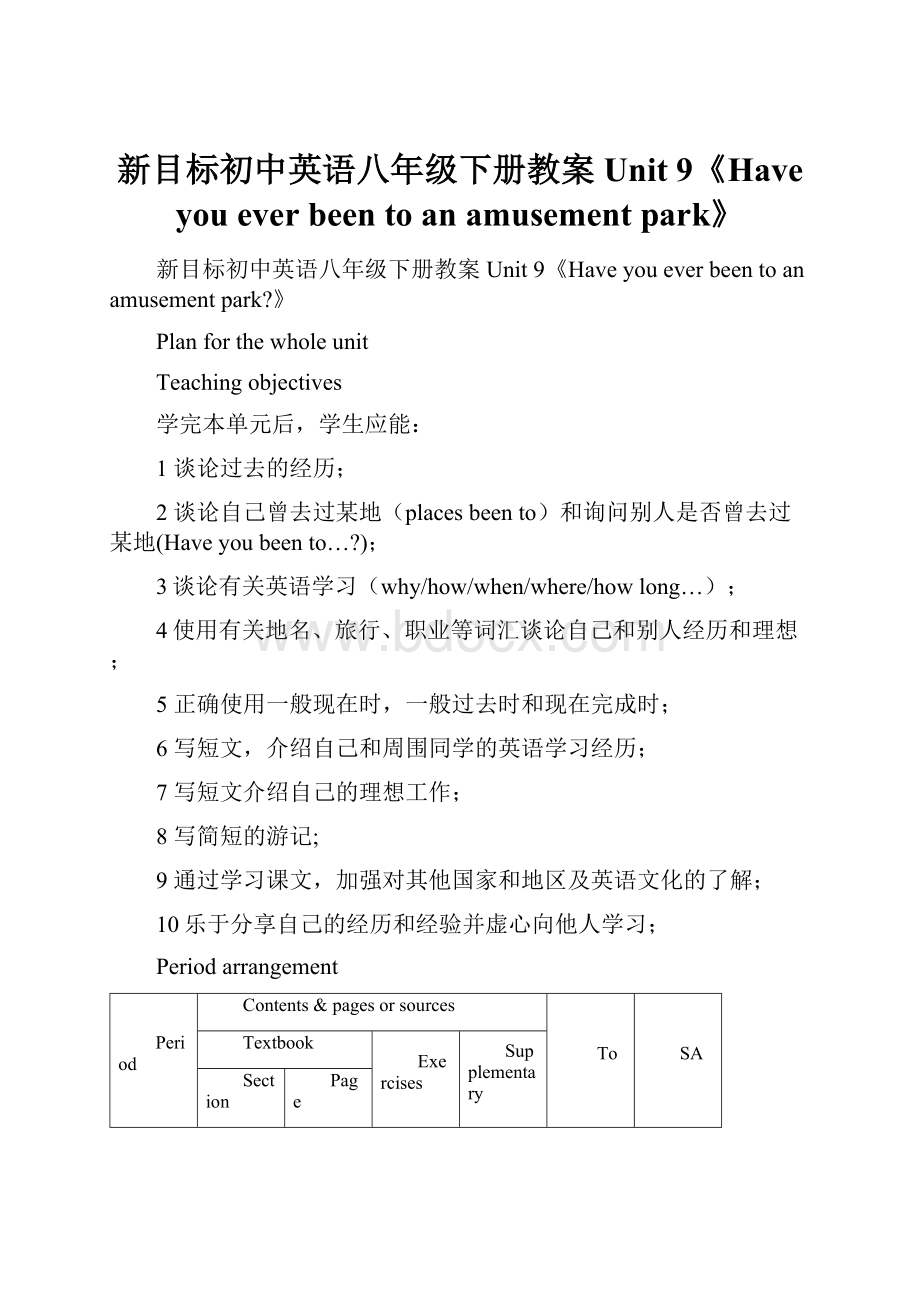新目标初中英语八年级下册教案Unit 9《Have you ever been to an amusement park》.docx
《新目标初中英语八年级下册教案Unit 9《Have you ever been to an amusement park》.docx》由会员分享,可在线阅读,更多相关《新目标初中英语八年级下册教案Unit 9《Have you ever been to an amusement park》.docx(21页珍藏版)》请在冰豆网上搜索。

新目标初中英语八年级下册教案Unit9《Haveyoueverbeentoanamusementpark》
新目标初中英语八年级下册教案Unit9《Haveyoueverbeentoanamusementpark?
》
Planforthewholeunit
Teachingobjectives
学完本单元后,学生应能:
1谈论过去的经历;
2谈论自己曾去过某地(placesbeento)和询问别人是否曾去过某地(Haveyoubeento…?
);
3谈论有关英语学习(why/how/when/where/howlong…);
4使用有关地名、旅行、职业等词汇谈论自己和别人经历和理想;
5正确使用一般现在时,一般过去时和现在完成时;
6写短文,介绍自己和周围同学的英语学习经历;
7写短文介绍自己的理想工作;
8写简短的游记;
9通过学习课文,加强对其他国家和地区及英语文化的了解;
10乐于分享自己的经历和经验并虚心向他人学习;
Periodarrangement
Period
Contents&pagesorsources
To
SA
Textbook
Exercises
Supplementary
Section
Page
1
A1a,1b,1c
68
1
5
2
2a,2b,2c
69
Ps.50-51I,II
湘教版
省教科院组编《课程基础训练
八年级下册》
2、6
5
3
3a,3b,4
70
P.51II
2
4
4
B1a,1b,2a,2b,2c
71
Ps51-52I,II
8
4
5
3a,3b,3c,4
72
P.52II
7、5
5
6
Selfcheck1,2,3
73
Ps.52-53学习自检,学习拓展
3、9
4
7
Total
73
Feedback
本单元教学自评93分,表明教学目标达成度较高。
整个单元教学回归教材,紧紧围绕“谈论过去的经历”这一主题,由浅入深、由简单到复杂,从谈论别人到最终介绍自己展开,教学活动形式多样,教学步骤步步递进、环环相扣,形成合力,从听、说、读、写诸方面培养学生这一话题的表达能力。
由于教学内容紧扣学生实际,学生积极投入各项学习活动,勇于表达自己的真情实感。
同时,在听取别人的学习经验的过程中,体会到学习方法的重要性和勤奋努力的效果,从而优化自己的学习方法、形成积极竞争、相互促进的学习氛围。
为了减轻学生课余学业负担,提高教学效率,教材所涉及的所有练习,包括增加的多个写作练习都安排在课堂完成。
就其成功原因主要在于,课前我们认真研读了教材,尽可能吸取了与教材配套的《教师教学用书》提供的中英文教学建议,并结合学生的实际,从单元整体备课,细化单元及课时教学目的,合理安排课时教学内容,并在尽可能多的预设教学活动的前提下,关注课堂生成,随时根据学情调整教学活动,因而教学收到了良好的效果。
但课后在不增加学生过重课业负担的前提下,如何指导学生开展预习、复习、落实知识点的理解与应用,坚持课外阅读、培养能力等方面还有待进一步探讨研究。
Planforeveryperiod
Period1SectionA(1a,1b,1c)
Teachingaims
1是否去过某游乐场所
2识记游乐地点
3ever
4现在完成时的意义及构成、肯定和否定回答
Teachingprocedures
Chart
看图复习已学词汇,学习新词汇—看图说话—听录音完成表格—就图中地点进行话题操练—布置作业
Step1Checkingup
T:
Howmanyamusementplacesdoyouknow?
SectionA1a
Step2Talkingaboutthewords
1学生根据图片学单词
T:
Pointingtoeachofthepictures
Lookatthepicturesatthetop.Whatplaceisit?
S:
Azoo.
T:
Howdoyouknow?
S:
BecauseIcanseeaneagle.
T:
Howabouttheothers?
2带读单词
3根据描述猜单词
T:
Forexample:
It’saplacewherewecanenjoyourselvesinthewater.Tellme,whatplacewillitprobablybe?
4根据你的喜好排列这些游乐场所
T:
Differentpeoplehavedifferentopinions.Put1aftertheplaceyouwouldmostliketovisit.Put2afterthenextplaceyouwouldliketovisit,andsoon.
5统计班上同学最愿去的地方
Askingastudenttowritethefiveplacesontheblackboard.
T:
Howmanystudentswanttovisitthespacemuseumthemost?
Howmanystudentswanttovisitthezoothemost?
Writingtheresultsaftereachphraseontheboard.
Step3Leading-in
T:
Ididn’twanttogototheamusementplaces.SoIwenttoBeijingthissummer.
Writingthesentenceontheboard.IwenttoBeijingthissummer.
Thatistosay,I’vebeentoBeijing.(Writingdownthesentence.)
T:
Tina,haveyoueverbeentoBeijing?
S1:
Yes.
T:
Yes,Ihave.
T:
Class,repeattheshortconversation.
T:
Ruth,haveyoueverbeentoBeijing?
S2:
No,Ihaven’t.
T:
Class,repeat.
T:
Haveyoueverbeentoazoo\anamusementpark?
Pointingtothesentencesandremindingthemofthearticle“a”“an”.
Practicewithseveraldifferentstudentsandhavetheclassrepeatseveral“Haveyouever…”questionsaswellastheanswers“Yes,Ihave”and“No,Ihaven’t.”
T:
Justnow,weweretalkingaboutthepastexperiences.Actually,wehavetwoways.
Pointingthesentence:
IwenttoBeijingyesterdayWecanusethepastsimpletenseandalsowecanusethepresentperfecttense.
Pointingthesentence:
IhavebeentoBeijing.
Whenwewanttoknowwhetheranyonehasbeentosomecertainplace.,wealwaysaskinthisway:
“Haveyoueverbeento…?
”“ever”meansatsomeindefinitetimeinthepast,possiblyayearago,possiblyseveralyearsago.Contrastthatsentencewiththissentencewithouttheword“ever”:
DidyougotoBeijingyesterday?
Thissentenceisaskingaboutonespecifictimeinthepast.
Step4Practicingdialogues
1师生示范
2同桌操练
3小组操练
1b
Step5Listening
1提示语
T:
YouwillhearaconversationbetweenSarahandClaudia.Aftertheconversation,checktheplacesthetwogirlshavebeento.
2静听录音,完成表格
Answers
Claudia:
spacemuseum,aquarium,zoo
Sarah:
aquarium,zoo.Amusementpark
Tapescript
Sarah:
I’mbored,Claudia.Let’sdosomethingdifferent.
Claudia:
Haveyoueverbeentoanamusementpark?
Sarah:
Yes,Ihave.IwenttoFunTimesAmusementParklastyear.Haveyoueverbeentoawaterpark?
Claudia:
No,Ihaven’t,Sarah.
Sarah:
Meneither.Let’sgotoWaterCitytomorrow!
Claudia:
Well,thatsoundsfun,butIcan’tswim.
Sarah:
Really?
Ididn’tknowthat.Well,howaboutthezoo?
Haveyoubeentothezoo?
Claudia:
I’vebeentothezooalotoftimes.
Sarah:
Me,too.AndI’vebeentotheaquriumalso.
Claudia:
SohaveI,Sarah.Iwentthereonourlastschooltrip.
Sarah:
Iknow,Claudia.Let’sgotothespacemuseum.I’veneverbeenthere.
Claudia:
That’sagreatidea.Iwenttherelastyear,butI’dliketogothereagain.
1C
Step6Practice
Step7Homework
1Recitethedialogues
2Readastoryabouttravel
3Designthesituationalconversations,usingthepresentperfecttense
Feedback:
我认为本堂课教学目标基本达成,层次清晰,学生能听懂。
巧妙设计了“Haveyoueverbeento…?
”后面所接不同地点的表达法,通过自主探究,学生能明白其中的不同。
但现在完成时这个重要的知识点是“老师讲解—学生知道”的模式展开的,学生没有进行太多的自主体验。
课堂还不够紧凑,单词教授时设计的活动比较难,所以费时比较多。
思考:
针对课本安排,什么时候将现在完成时的语法知识教授给学生?
Period2SectionA(2a,2b,2c)
Teachingaims
1谈论去(过)某地
2两种时态的比较
3现在完成时的句式变化
Teachingprocedure
Chart
检查预习情况—语音训练—听力理解---交际对话---语法拓展
2a
Step1Checkingup
学生利用“现在完成时”的意义表演情景对话
Step2认读城镇交通图中的地名,为听力做准备
T:
Who’swillingtowriteontheboardthenamesoftheallplaceslistedonthemap?
T:
(Pointtothemap)Youwillhearthreeconversations.Eachconversationisaboutadifferentplaceonthemap.Circletheplacesyouhear.
(playtherecordingtwice)
Answers
spacemuseum,aquarium,zoo,WaterWorld,RiverPark
录音原文
Conversation1
Tina:
It’srainingagain,John!
Ireallywantedtogoskatingtoday!
John:
Oh,well.Hey,haveyoueverbeentothespacemuseum?
Tina:
Yes,Iwenttherelastyear.Haveyoueverbeenthere?
John:
No,Ihaven’t.
Tina:
Well,I’dreallyliketogothereagain.
John:
Great.Whatbusdowetaketogettothemuseum?
Tina:
Wecantakethesubway.Thestationisnearthemuseum.
Conversation2
Kim:
Haveyoueverbeentotheaquarium,Linda?
Linda:
No,Ihaven’t.ButI’mgoingtherenextweek.Wouldyouliketocome?
Kim:
Sure.Howwillwegetthere?
Linda:
Wecanrideourbikes.
Kim:
Whereistheaquarium?
Linda:
It’sonGreenStreet,behindthezoo.
Kim:
Haveyoubeentothezoo?
Linda:
Yes,Ihave!
Ilovethezoo.Iwenttherethreetimeslastyear.
Conversation3
Tom:
HaveyoueverbeentoWaterWorld,Harvey?
Harvey:
No,I’veneverbeenthere.
Tom:
NeitherhaveI.Let’sgo!
Harvey:
I’dreallylovetogo,butIdon’thaveanymoney.
Tom:
Well,let’sgoskatinginstead.There’sagreatnewplaceforskatingonCenterStreetinRiverPark.
Harvey:
That’sagreatidea.CouldIborrowyourbike?
Iwanttogohometogetmyskates.
2b
Step3Listening
(Ask3studentstoreadthestatements)
(Askstudentstocircletheword“true”
or“false”aftereachstatement.
Answers
Conversation1:
T,T,T
Conversation2:
F,T,F
Conversation3:
F,T,T
2c
Step4Group-work
(Pointtothemapandtellstudentstheycantalkaboutanyoftheplacesonthemap)
T:
Whocangiveusanexample?
Now,followtheexamples,andyou’reencouragedtousesomenewways.
Talkaboutplacesyouhavebeenandplacesyouwanttogo.Talkabouthowyouwillgettotheseplaces.
A:
Haveyoueverbeentoanamusementpark?
B:
Yes,Ihave.
A:
Howaboutyou,c?
C:
Me,too.Iwenttoanamusementpark2yearsago.
B:
Whodidyougowith?
C:
Iwenttherewithmyparents.
A:
Havetheyeverbeentoanamusement
park?
C:
No,never.
……
1hasbeento与havebeento
T:
Answermyquestionsaccordingto2a,andIcanseewhohasreallyunderstood.(TofF)
Lindahasbeentotheaquarium.
Johnhasneverbeentothespacemuseum.
Harvey’sfriendhasneverbeentoWaterWorld.
T:
(CAI)Let’slookatthethreesentences.Canyoufindanythingspecial?
S:
“havebeento”hasbeenchangedinto“hasbeento”
T:
Whyisthechange?
S:
Becausethesubjectisdifferent.
T:
Anddidyounotice“ever”and“never”?
S:
Yes,thenegativeanswerusestheword“never”.
T:
Compare:
Hehasneverbeentothespacemuseum.
Hehasn’tbeentothespacemuseum.
2一般过去时与现在完成时
T:
(Pairwork)
Let’sdosomeexercisesaboutthesentencespatterns
Pleaseworkinpairs,changingtheaffirmativesentencesin2bintootherforms.
Forexample:
HasLindabeentotheaquarium?
Yes,shehas.
Shehasn’tbeentotheaquarium.
3Practice:
(Group-work)
T:
Twostudentsaskandansweraccordingtoonesetofthestatements,andthethirdstudentmakeareport.Trynottomakeanymistake.
Step6Homework:
1.Exercisebook
2.Readahumorousstorythatinterestsyou.
3.Anoralcompositionaboutyourtravelexperience.
Feedback
我认为这节课自我感觉不错,学生将功能与语法、听力想结合,开展了组内活动。
为了让学生集中精力,我随意让一个学生将前两人的对话变成报告,这样既锻炼了口头表达能力,又能让所有同学体会到句式的变化,避免枯燥无味低效。
但这样的课堂活动,除了将地图中的地点找出来这个环节照顾了后进生外,其余环节都有点难度。
而且,让学生这样学语法到底是思路不清楚,还是并非单纯学语法。
Period3SectionA(3a,3b,4)
Teachingaims
1阅读策略
2介绍你的游玩经历
3过去分词的规则变化与不规则变化
Teachingprocedures
Chart
预习检查导入—对迪斯尼的了解—阅读策略—语言点—复述---对话练习---由你的不同经历引出对过去分词变化形式的分析
Step1Checkingup
检查学生就游玩经历的口头表达能力,能否将时态变换运用自如。
SectionA3a
Step2Readingcomprehension
1lead-in
HowmanystudentshavebeentoDisneyland?
Whatwereyouinterestedin?
HowmuchdoyouknowaboutDisneyland?
2Readthroughthetext,andcircletheinterestingthingsandunderlinetheboringthings.
3Listentothetape,andaskthemiftheyhaveanyquestionsaboutwordsorphrasesinthearticle.
T:
Whatdoes“theme”mean?
(Anidearunningthroughoutsomething)
4Readingstrategy:
Readagain,andtrytogetthemainmeaningofeachparagraph.Wewillseethatthefir